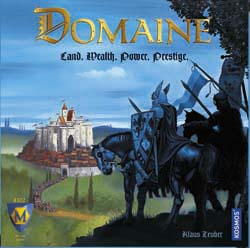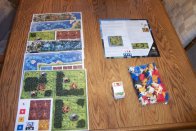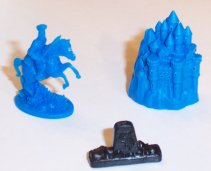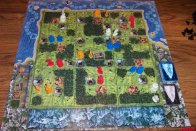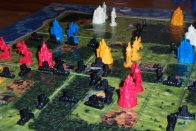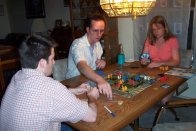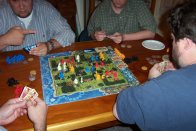
|
Domaine - Land, Wealth, Power, Prestige A game by Klaus Teuber Published by Mayfair Games, Inc. and Kosmos Players: 2 to 4 Time: 60 minutes Reviewed by Ed Rozmiarek with additional comments by Susan Rozmiarek |

|
| "The king tarries in a far-off land. In his absence the kingdom falls into chaos and disorder. Each duke seeks to build up his own power and influence. Borders will be drawn, the kingdom divided. Who will control the most valuable regions when the king returns?" |
Domaine - Land, Wealth, Power, Prestige
from Mayfair is the English language version of the game Löwenherz from Kosmos.
This is a reworked version of Löwenherz originally published by Goldsieber and Rio Grande Games
and winner of the 1997 Deutscher Spiele Preis best game of the year award.
The game has been modified in this new version (including the background story quoted above)
but many of the mechanics from the original version remain.
If you are a fan of the original Löwenherz, you may want to skip to the
Löwenherz vs Domaine section below.
(Note: For the remainder of this article, Löwenherz will mean the prior version
of the game while Domaine mean the new version.)
The players start the game by placing 3 (with 4 players) or 4 (with 2 or 3 players) castles on the board.
These castles are protected by a knight which must be placed orthogonally adjacent to the castle.
Each player also receives a small amount of money (ducats) and a hand of three action cards.
The player who placed the last castle is the start player.
There are five types of actions listed on the action cards.
These should look familiar to those who have played Löwenherz.
They are:
Mines that are within the player's domaines produce income each turn.
For each unique type of mine (there are four: gold, silver, bronze and diamond) that a player
controls, he receives one ducat each turn.
So if a player has two diamond mines and a gold mine, he gains two ducats each turn.
Generating this extra income is important as it will allow a player to play more actions
cards since he will need to sell fewer cards to generate income.
Also, if a player controls three or more of the same type of mine, he gets a five point
bonus to his score.
The bonus may be lost if the player loses control of the mines.
The game ends in one of two ways.
The first is if one player scores a set number of points (30 in the 4 player game,
40 in the 3 player and 50 in 2 player).
This player is the winner.
However, the game may also end if the draw deck of action cards is exhausted.
In the case, play continues as normal until all players are out of action cards with
the restriction that players may no longer draw cards from the Chancery.
Once all cards have been played or sold, the player with the most money gets a
five point bonus and the one with the second most money gets a three point bonus.
The player with the most points wins.
Money in the game is very tight.
Playing cards to take actions requires money and the most common way to get money is
by selling action cards and skipping an opportunity to accomplish something on the board.
In general, the more powerful a card, the more it costs to play but also,
the more it is worth to sell.
This provides many decision points during the game as you must decide if it is better
to sell a powerful card to get needed money but knowing that one of your opponents will
most likely pick up the card.
On top of this, the actions generally get slightly more expensive later in the game.
Placing a knight early may only cost three ducatsd early but will cost four ducats later
when you may need the extra defense for a domaine.
Owning mines is the best way to provide that extra needed income to offset the need to
sell cards.
Getting an early domaine that produces a couple ducats each turn can prove very beneficial.
Many people consider Löwenherz to be a "nasty" or mean game since the negotiations for actions
and the fight for land on the board pit the players in direct competition.
Domaine is not quite as mean due to the removal of the competition for actions but
there still plenty of opportunities to butt heads with the other players.
The game still centers around carving out your space on the board, protecting it and enlarging it if possible.
In the original Löwenherz the Renegade card teamed with an expansion action,
provided a very power threat.
Someone could easily upset the balance of power and then expand into an underprotected region.
In Domaine, the Deserter card has the same function but it is a single action and is
one of the more expensive cards to play.
Also, given that it takes an additional turn to take advantage of the results of the deserter,
it does not feel as much of a threat as the Renegade card in Löwenherz as
the person hit with the Deserter may have the opportunity to recover before any expansion into his domaine occurs.
On the other hand, the Alliance action seems more powerful in Domaine than in the Löwenherz.
Having the ability to defend against a more powerful domaine for the remainder of the game is very nice.
But again, at five ducats to play, the Alliance card is relatively expensive.
Our games have clocked in at about an hour (after rules explanations), right in line
with the box estimate.
For our four player games, the game seems a little too short.
The game seems to be just getting interesting when the cards run out.
The players seem amazed when the "C" section of the action deck arrives marking the midway point
and they have not accomplished what they had to do.
However, this does place a premium on making the most of your moves, especially the early ones,
and causes a good deal of turn angst.
Susan's Comments:
I always considered Löwenherz to be an underrated game that faded into
obscurity without getting the widespread attention it deserved.
Thus, I was very pleased to see a new version being released that has the potential
to reach a wider audience.
There are many changes to this version that are going to be met with a mixed reaction
by fans of the original game.
A few of these changes I consider definite improvements:
The new card play in Domaine that determines player actions is the change that is
liable to generate the most controversy.
The negotiation and power struggles for actions provided a higher level of nastiness and
challenge that some players are going to prefer.
The diminished role of political cards is another reduction in this nastiness.
My feelings are mixed on this issue.
I must confess, the original Löwenherz was capable of raising my stress level to uncomfortable heights.
Every part of the game was potentially a struggle.
On the one hand, it was fun to dish out punishment to fellow players, but on the other hand,
it was deflating to be on the receiving end of said punishment.
In Domaine, at least a small part of the game you can manage without too much interference from other players.
I can honestly say I had more fun playing Domaine, but I truly believe it is going
be a matter of personal preference.
In general, the more powerful a card is, the more money it takes to play.
For example, a one wall card may cost only one ducat to play whereas a three wall card will cost six ducats.
Ed's Comments:
On some of the internet gaming discussion groups,
it has been commented
that Klaus Teuber's goal with this new version of the game was to streamline the game
play while keeping the game's central character.
In that regard, the game succeeds.
Without the negotiations for actions each turn, the game flows much more smoothly.
Each player gets to do something on their turn by either selling or using a card.
The changes allow the players to plan a little further ahead since they have their
possible actions in the cards they are holding.
There is some randomness in the card draw, but this is mitigated by the ability
to draw known cards from the Chancery.
| Difference | Löwenherz | Domaine |
| Back story | The King is dying | The King is out of the country |
| Game end condition | When the "King Dies" card is revealed from the card stack. | First player to set number of points or the action card deck is exhausted. |
| Determining player actions | All players vie for one of the three possible actions that round. | Player selects one of his three action cards. |
| Board size | 150 spaces (10 x 15) | 144 spaces (12 x 12) |
| Knights per player | 12 | 15 |
| Scoring | Victory points based on the size of region when it is formed. Additional points for enlarging a region and for owning mines at the right time. | Victory points for forests and towns enclosed within a region or "domaine". Additional points for enlarging a domaine to include additional forests and towns, owning a mining monopoly and for most and second most gold at the end of the game. |
| Mines | Generate victory points four times during the game. | Generate money each turn. |
| Alliances | Last for one turn and may be cancelled by payment. | Lasts for the rest of the game with no way to cancel. |
Conclusion: I have certainly enjoyed my playings of Domaine so far. There is enough meat in the position battles on the board and the money management to provide most people plenty of tough decisions. You must pick your battles and make the most of the limited resources you have. On a 10 point scale I would say Domaine is a strong 8, possible going to a 9 if the game holds up well to more playings. The ability to play well with fewer than 4 players is a definite advantage Domaine has going for it over the original game. However, I really wish there were another 9 to 12 cards in the deck to lengthen the game a bit to provide the opportunities for additional strategies.
Other Web information:
This page viewed
E-mail Ed Rozmiarek with questions or problems concerning this page.
Copyright © 2003, Ed Rozmiarek
